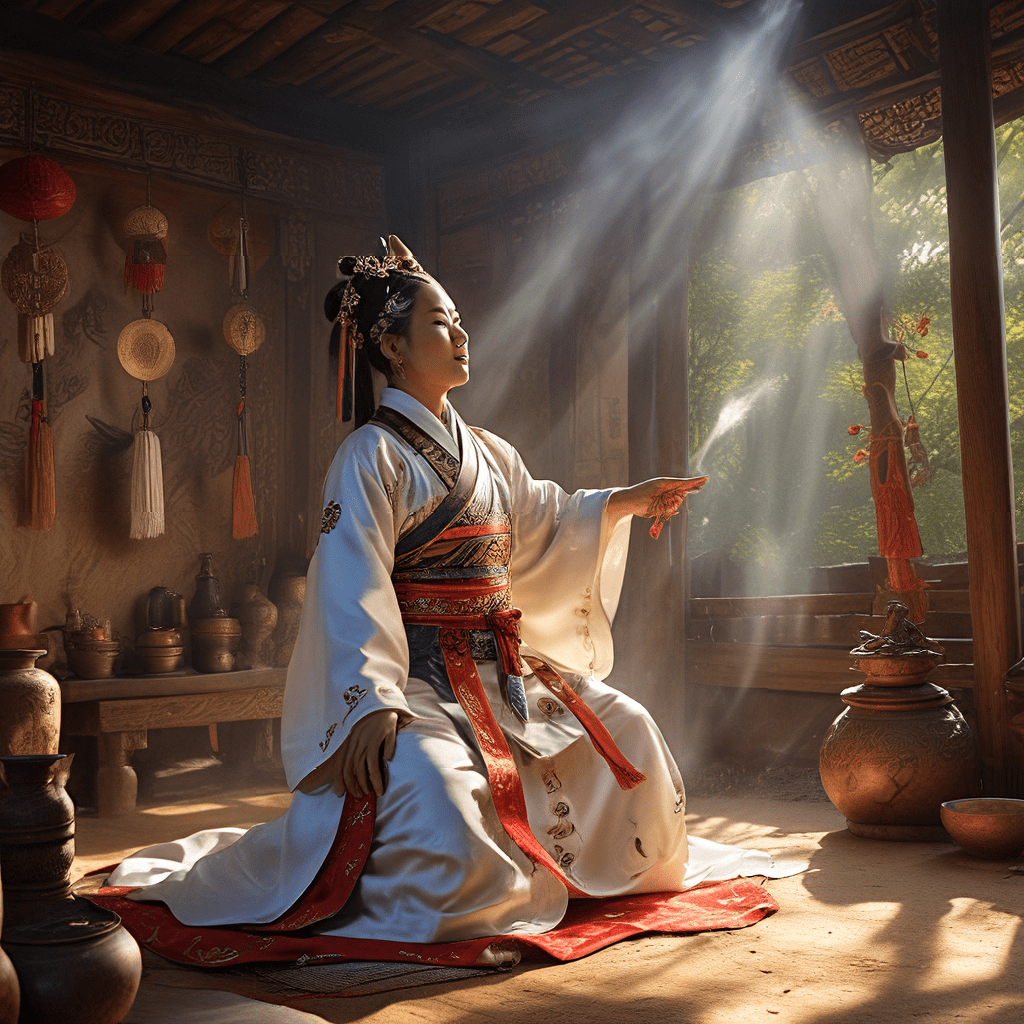Korean Shamanism: A Brief Overview
Korean shamanism, known as "mudang" (무당), is an ancient tradition that has been practiced for centuries on the Korean peninsula. It is a vibrant, multifaceted belief system that encompasses a deep connection to the natural world, ancestral spirits, and a diverse pantheon of deities. Unlike many organized religions, Korean shamanism is not a monolithic belief system but rather a rich tapestry of local customs, beliefs, and practices that have evolved over time. At its core lies the belief that the world is interconnected by a network of spirits, known as "shin" (신), who can influence human lives. Shamanic rituals aim to appease these spirits, seek guidance, and restore balance to individuals and communities.
The Role of the Shaman: Mudang
The heart of Korean shamanism is the "mudang", a spiritual practitioner who acts as a mediator between the human world and the spirit world. Mudang are often women, although men can also become shamans. They are believed to be chosen by spirits to serve as their intermediaries, receiving divine power through initiation rituals. These rituals often involve intense training, purification, and the acceptance of hardship. The mudang's role is multifaceted, encompassing a wide range of practices including:
- Healing: Mudang diagnose illnesses and perform rituals to heal both physical and mental ailments.
- Exorcism: They drive away evil spirits and malevolent entities that are believed to cause misfortune and illness.
- Fortune-telling: Mudang provide guidance and advice on important life decisions, seeking insights from spirits about future events.
- Ancestor veneration: They perform rituals to honor and appease the spirits of ancestors, ensuring their well-being and continued protection.
- Community rituals: Mudang conduct rituals for important events such as weddings, funerals, and agricultural festivals, seeking blessings and harmony for the community.
Mythology and Cosmology: The Three Worlds
Korean shamanism is steeped in rich mythology and cosmology, with a unique understanding of the universe. The cosmology of Korean shamanism is based on the concept of "Sam-Cheon," the three worlds:
- Heaven (Cheon): The highest realm, ruled by the supreme deity, "Hwan-in" (환인), and inhabited by various Gods and Goddesses who are responsible for the natural world and human fate.
- Earth (Ji): The human realm, where people live and interact with the spirits of nature and ancestors.
- Underworld (Ji-ok): The realm of the dead, governed by "Yeomra" (염라), the King of Hell, where the spirits of the deceased are judged and assigned to different realms based on their actions in life.
This intricate cosmology provides a framework for understanding the interconnectedness of the spiritual and physical realms, shaping the rituals and beliefs of Korean shamanism.
Essential Ritual Elements: Music, Dance, and Offerings
Shamanic rituals are a dynamic expression of belief, involving a combination of music, dance, and offerings to connect with the spirit world.
- Music: The use of drums, gongs, flutes, and other traditional instruments is integral to creating a sacred atmosphere. The rhythmic sounds and melodies are believed to summon spirits and facilitate communication.
- Dance: Mudang perform ritual dances that are often energetic and expressive, symbolizing a journey to the spirit world and embodying the power of the spirits they are invoking.
- Offerings: Food, drink, and other objects are presented as offerings to appease and honor the spirits. These offerings can include traditional Korean dishes, wine, silk, and flowers.
Types of Rituals: Healing, Exorcism, and Fortune Telling
Korean shamanic rituals are categorized according to their purpose, with each serving a specific function in the lives of individuals and communities.
- Healing Rituals: These rituals aim to diagnose and treat illness by identifying the spirit responsible for the ailment. The mudang seeks to appease the spirit through offerings and prayers, restoring balance to the individual's energy.
- Exorcism Rituals: When a person is believed to be possessed by an evil spirit, the mudang performs an exorcism to drive the entity away. This often involves chanting, drumming, and summoning powerful spirits to protect the individual.
- Fortune-Telling Rituals: Mudang draw upon their connection to the spirit world to provide guidance and insights into the future. They use divination methods such as fortune cards, throwing rice seeds, or reading the patterns of smoke from incense to interpret messages from the spirits.
The Concept of “Shin” (Spirits): Ancestral and Nature Spirits
Korean shamanism revolves around the belief in "shin" (신), a vast network of spirits that inhabit the universe. These spirits can be benevolent or malevolent, and they play a significant role in human lives, influencing everything from health and prosperity to personal relationships and destiny.
- Ancestral Spirits (Choson): Korean culture places great importance on honoring ancestors. The spirits of deceased family members are believed to remain close to their descendants, offering guidance and protection. Mudang conduct rituals to appease ancestral spirits, ensuring their well-being and continued support for the living.
- Nature Spirits (Sangsang): The natural world is seen as teeming with spirits that embody the power of mountains, rivers, forests, and other natural elements. These spirits are often associated with specific locations and are revered for their influence over the environment and its bounty. Shamanic rituals often involve seeking blessings from these spirits for good harvests, weather, and protection from natural disasters.
The Importance of Possession: The Shaman’s Connection to Spirits
A core element of Korean shamanism is the concept of "shin-gam" (신감), which translates to "spirit possession." Mudang are believed to be chosen by spirits to serve as their intermediaries, and during rituals, they are often possessed by these spirits. This possession is not seen as a loss of control but rather a manifestation of the spirit's power flowing through the shaman.
- Signs of Possession: Physical manifestations of possession can include altered breathing, speaking in different voices, and displaying extraordinary strength or agility. These actions are seen as the spirit expressing its will and communicating with the human world.
- Benefits of Possession: Possession allows the mudang to access the knowledge and power of the spirits they embody. This empowers them to perform healing rituals, exorcisms, and other sacred practices with greater effectiveness.
Shamanic Initiation: The Path to Becoming a Mudang
Becoming a mudang is not a simple decision; it is a calling that requires immense dedication, perseverance, and a willingness to undergo rigorous initiation rituals. This often involves a period of intense spiritual training and purification, culminating in a transformative experience that empowers the aspiring shaman with the ability to communicate with the spirit world.
- Selection by Spirits: The decision to become a mudang is often seen as being chosen by spirits. Individuals may experience dreams, visions, or other spiritual experiences that indicate their destined role as a shaman.
- The Ritual of "Gut": The primary initiation ritual is known as "gut," which is a complex and multi-day event. It involves drumming, dancing, chanting, and the consumption of sacred foods, all designed to cleanse the candidate's spirit and open them to the power of the spirits.
- Trials and Transformation: The initiation process is often demanding, testing the candidate's commitment and resilience. They may experience hardship, pain, and even illness as they undergo a spiritual transformation that prepares them for their role as a mudang.
Korean Shamanism and Traditional Culture: Intertwined Threads
Korean shamanism is deeply interwoven with traditional Korean culture, influencing art, music, literature, and everyday life.
- Folklore and Legend: Shamanic beliefs permeate Korean folklore and legends, shaping the stories and characters that have been passed down through generations.
- Festivals and Rituals: Shamanic rituals play a significant role in various traditional festivals, honoring ancestors, seeking blessings for good harvests, and celebrating important events.
- Art and Music: Shamanic themes and imagery are reflected in traditional Korean art and music, such as the vibrant costumes worn by mudang, the powerful rhythms of their drums, and the evocative melodies of their chants.
Modern Perspectives on Korean Shamanism: Revival and Adaptation
While Korean shamanism faced suppression during periods of modernization and Westernization, it has experienced a renewed interest in recent decades.
- Revival and Acceptance: As societal values shift, there has been a growing acceptance of shamanism's role in providing spiritual support, healing, and cultural identity.
- Adaptation and Innovation: Modern shamans have adapted their practices to meet the needs of contemporary society, incorporating elements of psychology, psychology, and other modern perspectives while preserving the core values of the tradition.
- Global Influence: Korean shamanism is gaining international recognition, with increasing interest from scholars and practitioners worldwide. This global attention is contributing to a deeper understanding and appreciation of this ancient tradition.
Frequently Asked Questions
What is the difference between Korean Shamanism and other forms of Shamanism?
Korean shamanism has unique characteristics, including its focus on the "shin" (spirits) and the importance of spirit possession in its rituals. It also has a strong emphasis on ancestor veneration and connections to the natural world.
Is Korean Shamanism a religion?
While Korean shamanism has a complex system of beliefs and practices, it is not formally considered a religion. It is often described as a folk tradition or a spiritual practice.
How can I experience Korean Shamanism?
If you are interested in learning more about Korean shamanism, you can visit cultural centers, museums, or participate in workshops and classes. You can also attend traditional festivals or visit sites that are considered sacred to shamans.
Is it possible to become a shaman?
While anyone can learn about Korean shamanism, the path to becoming a mudang is often considered a calling and involves a rigorous initiation process guided by experienced shamans.



